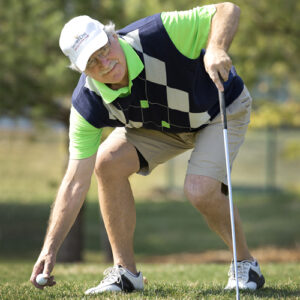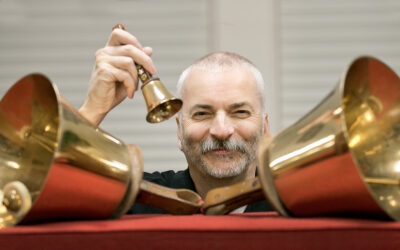When it comes to putting on the miles, fewer do more than avid cyclist, Tom Hannah, 64, Davenport. His goal this summer, a good 75 miles a week or about 300 miles a month, biking along the scenic trails and byways of eastern Iowa and western Illinois. Thanks to two total knee replacements, he’s back in the saddle with no more pain, swelling, or limping.
Davenport Cyclist Stronger after Total Knee Replacements

Not only was Tom back on his bike after his surgery, he was also back on the course!
When it comes to putting on the miles, fewer do more than avid cyclist, Tom Hannah, 64, Davenport. His goal this summer, a good 75 miles a week or about 300 miles a month, biking along the scenic trails and byways of eastern Iowa and western Illinois. Thanks to two total knee replacements, he’s back in the saddle with no more pain, swelling, or limping.
“I’m not one to lay around and take any time off,” declares Tom. But after a lifetime of athletics, including high school football, college wrestling, and rugby, Tom’s knees were beginning to wear out.
Pain and swelling started to limit his activity — not good news for a man on the move. “When I played golf, the pain got so bad I was limping, then my knee would swell up and throb. In the evenings, my knees hurt so bad they’d wake me up in the middle of the night. I just waited longer to get the surgeries than I should have.”

Dr. Peter Rink, ORA Orthopedics
Putting off surgery is not unusual says Tom’s physician, Dr. Peter Rink, an Quad City ORA Orthopedics’ joint replacement surgeon, who has been in practice for 24 years. “I usually don’t see patients until the pain begins to limit their life,” he says. “We explore every option before surgery and try to help patients with their symptoms.
Treatments can include anti-inflammatory medications, various injections, or physical therapy, but knees do wear out, and in Tom’s case, arthritis and his previous injuries made him a good candidate for total knee replacement.
“We both like to bike together and I knew Tom’s goal was to return to his normal level of activity, which is pretty significant when he cycles on average about 3 thousand miles a year,” says Dr. Rink.
Knee Replacement is a Viable Option for Active People
“Knees take a lot of stress,” he explains further. “As we age, we all experience wear and tear on our knees. Our joint surface is a very specialized material and when it’s injured, it doesn’t heal itself. At some point, it starts to become painful.” Dr. Rink compares the knee to a tire tread. “When the tread wears out, we get new tires. When the joint wears out, we start talking knee replacement. Some people’s joints are more prone to wear than others, including those with past injuries or who are overweight.”
Dr. Rink replaced both of Tom’s knees, the first in 2010 and the second in 2013.
He describes total knee replacement as a procedure that basically resurfaces the knee. “We remove the arthritic surface in surgery and then insert metal and medical-grade plastic components that replace the knee’s worn surface.”
The surgeries take about an hour and the patient is up walking right away. The hospital stay lasts only a day or two. After about six weeks of physical therapy, patients fully recover in about three months. In total, ORA physicians perform over 1200 total knee replacements each year.
Adds Tom, “I had no problems with either knee surgery. I was in the hospital a couple days. Rehab is tough, but not bad if you work at it. My goal was to get back to where I was before. There’s no getting around pain, but I got my life back within a couple of months, and it was worth it.
“Dr. Rink is great! We talked about options and he understood my desire to be active.” Now, Tom is looking forward to reaching his 300 mile monthly goal this summer. “I feel fine. I’m as good as ever.”
Davenport Cyclist Stronger after Total Knee Replacements

Not only was Tom back on his bike after his surgery, he was also back on the course!

Dr. Peter Rink, ORA Orthopedics
Knee Replacement is a Viable Option for Active People
“Knees take a lot of stress,” he explains further. “As we age, we all experience wear and tear on our knees. Our joint surface is a very specialized material and when it’s injured, it doesn’t heal itself. At some point, it starts to become painful.” Dr. Rink compares the knee to a tire tread. “When the tread wears out, we get new tires. When the joint wears out, we start talking knee replacement. Some people’s joints are more prone to wear than others, including those with past injuries or who are overweight.” Dr. Rink replaced both of Tom’s knees, the first in 2010 and the second in 2013. He describes total knee replacement as a procedure that basically resurfaces the knee. “We remove the arthritic surface in surgery and then insert metal and medical-grade plastic components that replace the knee’s worn surface.” The surgeries take about an hour and the patient is up walking right away. The hospital stay lasts only a day or two. After about six weeks of physical therapy, patients fully recover in about three months. In total, ORA physicians perform over 1200 total knee replacements each year. Adds Tom, “I had no problems with either knee surgery. I was in the hospital a couple days. Rehab is tough, but not bad if you work at it. My goal was to get back to where I was before. There’s no getting around pain, but I got my life back within a couple of months, and it was worth it. “Dr. Rink is great! We talked about options and he understood my desire to be active.” Now, Tom is looking forward to reaching his 300 mile monthly goal this summer. “I feel fine. I’m as good as ever.”Service Unavailable
The server is temporarily unable to service your request due to maintenance downtime or capacity problems. Please try again later.
Additionally, a 503 Service Unavailable error was encountered while trying to use an ErrorDocument to handle the request.




